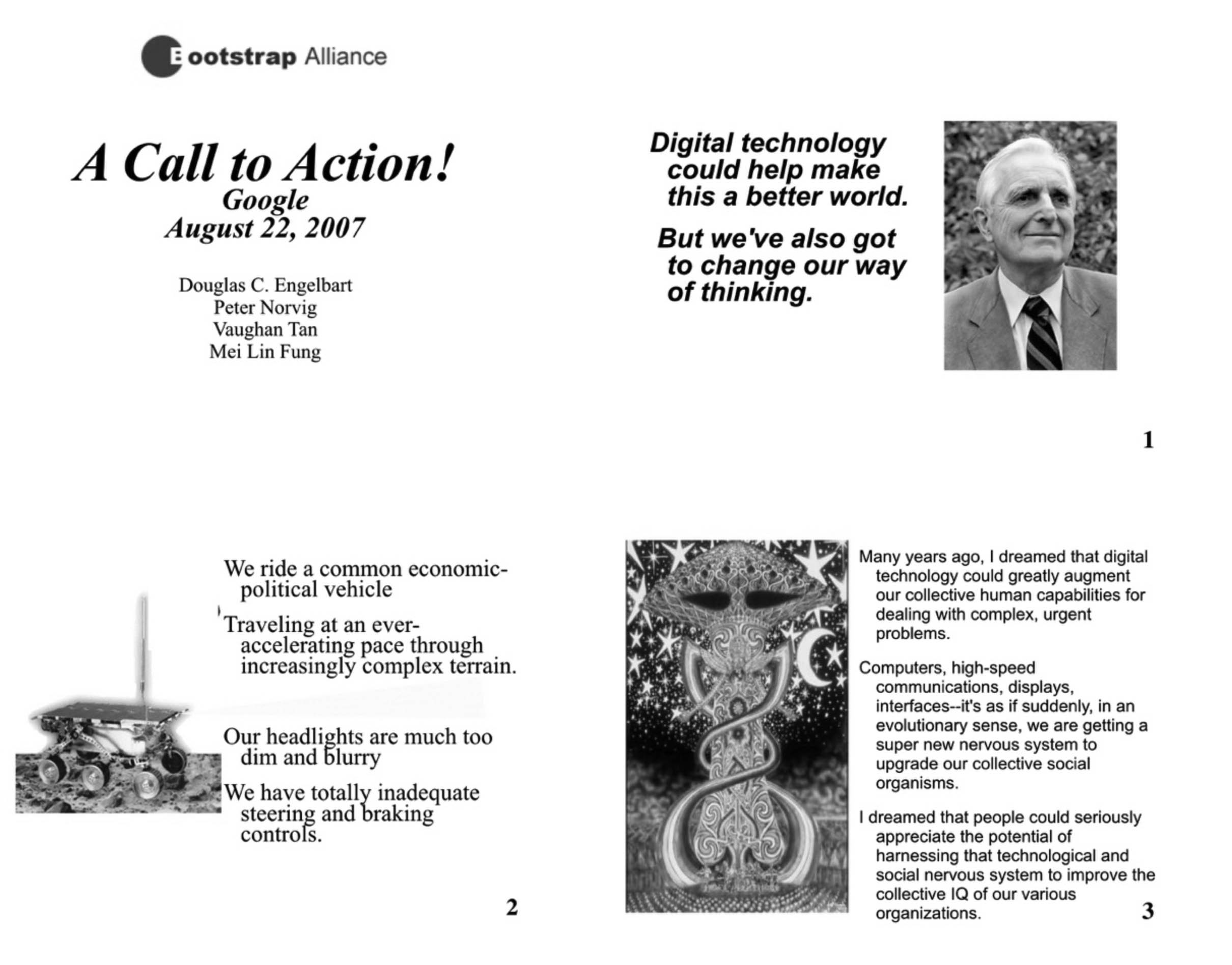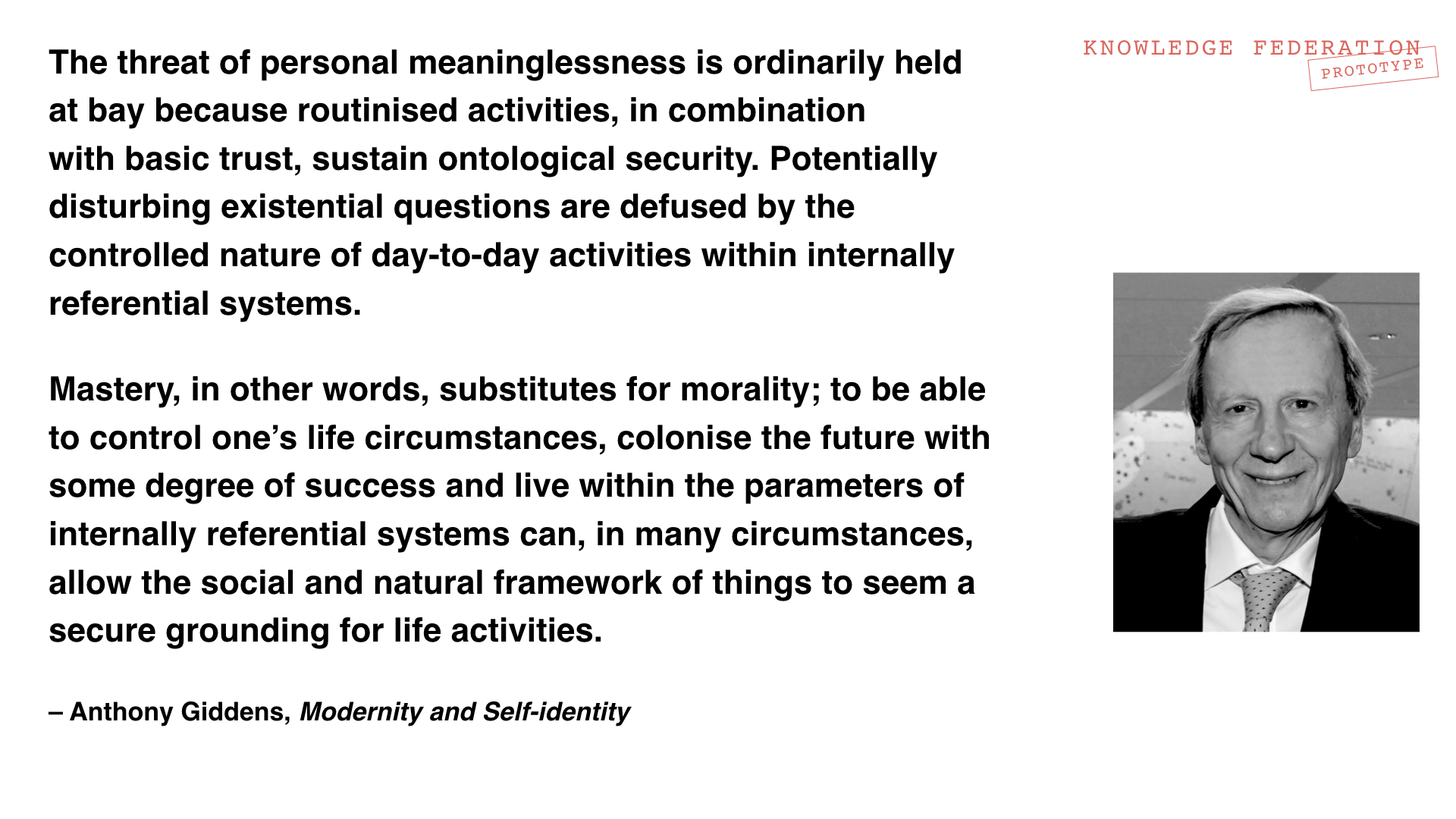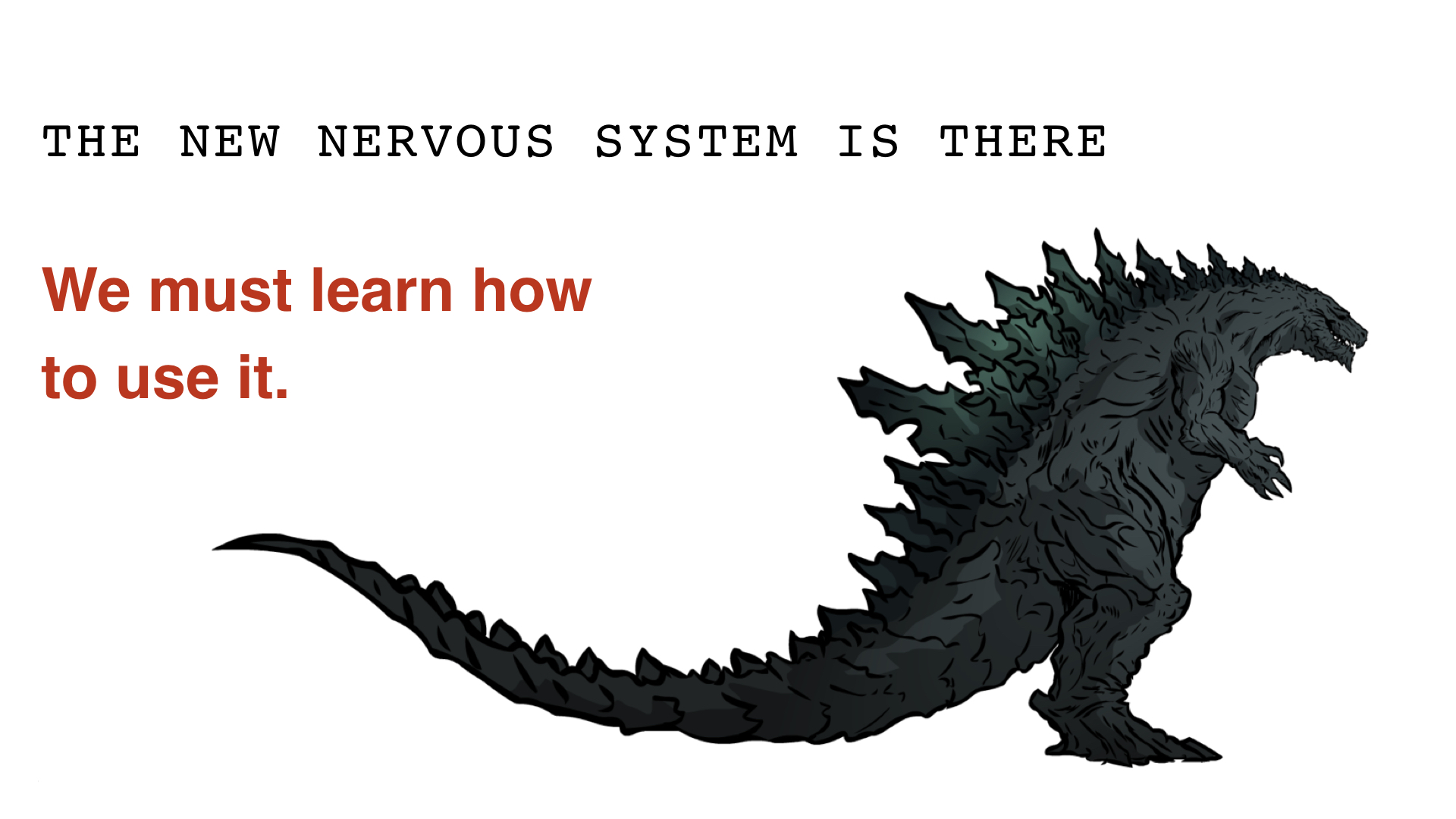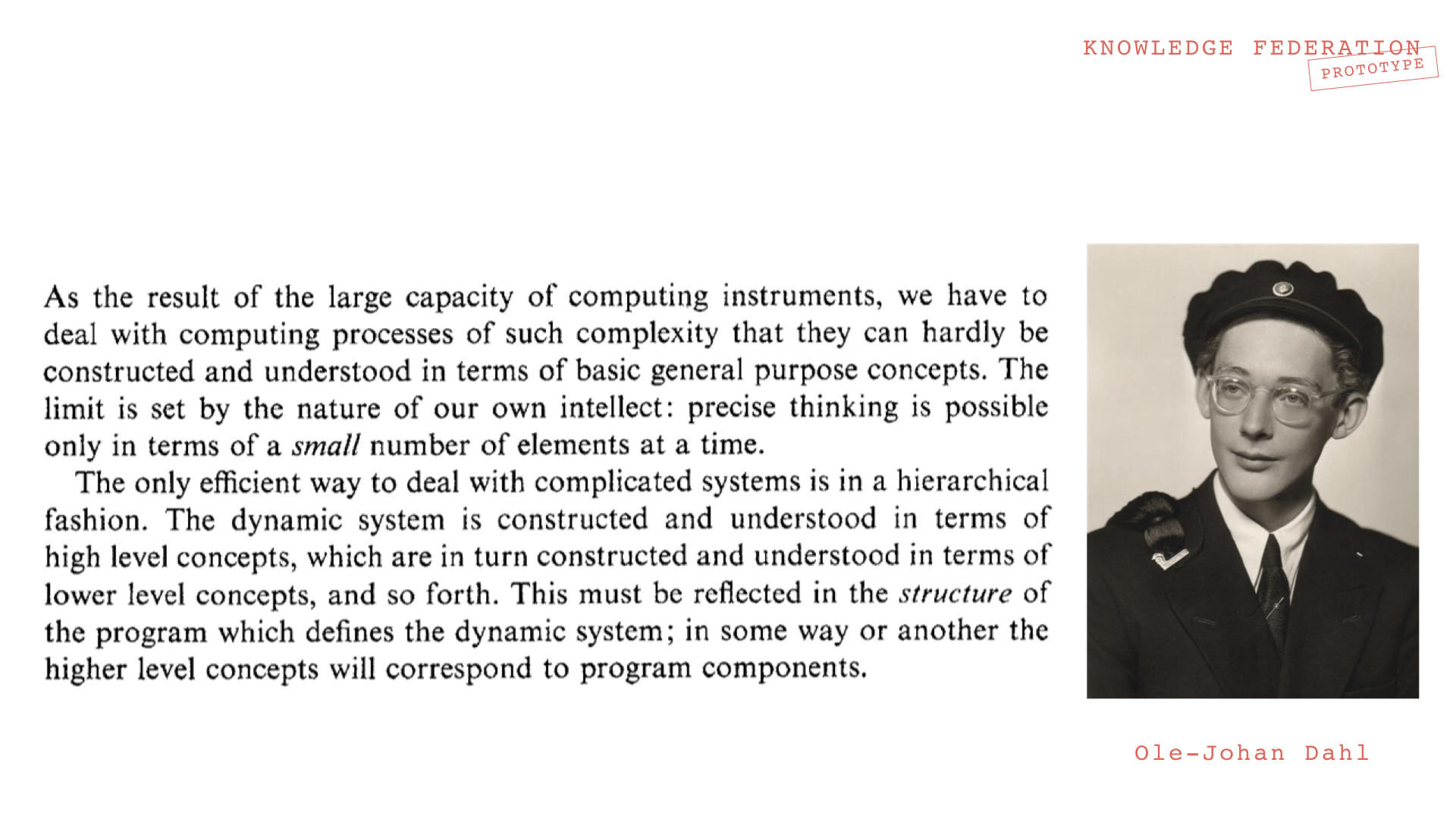Difference between revisions of "Holotopia: Collective mind"
m |
m |
||
| Line 90: | Line 90: | ||
| + | <div class="page-header" ><h2>Ideogram</h2></div> | ||
| + | |||
| + | |||
| + | <div class="row"> | ||
| + | <div class="col-md-3"></div> | ||
| + | <div class="col-md-7"> | ||
| + | <p> | ||
| + | [[File:KFvision.jpeg]] | ||
| + | </p> | ||
| + | <p>Our civilization is like an organism that has recently grown beyond bounds ("exponentially")—and now represents a threat to its environment, and to itself. By a most fortunate mutation, this creature has recently developed a nervous system, which could allow it to comprehend the world and coordinate its actions. But the creature is using it only to amplify its most primitive, limbic impulses.</p> | ||
| + | </div> </div> | ||
| + | |||
| + | |||
| + | <div class="page-header" ><h2>Keywords</h2></div> | ||
| + | |||
| + | |||
| + | |||
| + | <div class="row"> | ||
| + | <div class="col-md-3"><h2><em>Knowledge federation</em></h2></div> | ||
| + | <div class="col-md-7"> | ||
| + | <p>We use this keyword, <em>knowledge federation</em>, in a similar way as "design" and "architecture" are commonly used—to signify both a set of activities, and an academic field that develops them.</p> | ||
| + | <p>As a set of activities, <em>knowledge federation</em> can now be understood as the workings of a well-functioning <em>collective mind</em>. Instead of broadcasting, the cells and organs (researchers, disciplines, communities...) process the information they are handling and dispatch suitably prepared pieces to suitable other cells and organs. The prefrontal lobe receives what it needs. And so do the muscles. In the development of a <em>collective mind</em> that <em>federates</em> knowledge, the cells self-organize, specialize, develop completely <em>new</em> goals, processes, ways of working...</p> | ||
| + | <p>How does it all work? 'Programming' our <em>collective mind</em> is what <em>knowledge federation</em> as <em>transdiscipline</em> is all about. It draws insights from all relevant fields—and weaves them into the very <em>functioning</em> of our <em>collective mind</em>. Yes, this is roughly what philosophy was or appeared to be all about, in the old <em>paradigm</em>. </p> | ||
| + | <p>As an academic field, <em>knowledge federation</em> develops the <em>praxis</em> of <em>knowledge federation</em>. There is phenomenally much to be done—since everything that the <em>tradition</em> has given us and we customarily take for granted (all those 'candles'...) now need to be reassessed and reconfigured. </p> | ||
| + | <p> | ||
| + | [[File:Dahl-structure.jpeg]] | ||
| + | </p> | ||
| + | <p>In the analogy with computer programming, <em>knowledge federation</em> roughly corresponds to <em>object orientation</em>. Here is how Old-Johan Dahl, one of the creators of the Object Oriented Methodology, described the underlying idea.</p> | ||
| + | </div> </div> | ||
| + | |||
| + | |||
| + | <div class="row"> | ||
| + | <div class="col-md-3"><h2><em>Information holon</em></h2></div> | ||
| + | <div class="col-md-7"><p>It is offered as a counterpart to "object" in object oriented methodology (as we summarized [https://holoscope.info/2019/02/07/knowledge-federation-dot-org/#InformationHolon here]).</p> | ||
| + | |||
| + | <p>The Information <em>idogram</em>, shown on the right, explains its principle of operation.</p> | ||
| + | </div> </div> | ||
| + | |||
| + | <div class="row"> | ||
| + | <div class="col-md-3"></div> | ||
| + | <div class="col-md-6"> | ||
| + | <p>The <em>ideogram</em> shows an "i", which stands for "information", as composed of a circle placed on top of a square. The square stands for the details; and also for looking at a theme of choice from all sides, by using diverse <em>kinds of</em> sources and resources. The circle, or the dot on the "i", stands for the function or the point of it all. That might be an insight into the nature of a situation; or a rule of thumb, pointing to a general way to handle situations of a specific kind; or a project, which implements such handling.</p> | ||
| + | </div> | ||
| + | <div class="col-md-3"> | ||
| + | [[File:Information.jpg]] | ||
| + | <small>Information <em>ideogram</em></small> | ||
| + | </div> </div> | ||
| + | |||
| + | <div class="row"> | ||
| + | <div class="col-md-3"></div> | ||
| + | <div class="col-md-7"> | ||
| + | <p>By showing the circle as <em>founded</em> on the square, the Information <em>ideogram</em> points to <em>knowledge federation</em> as a social process (the 'principle of operation' of the socio-technical 'lightbulb'), by which the insights, principles, strategic handling and whatever else may help us understand and take care of our increasingly complex world are kept consistent with each other, and with the information we own. </p> | ||
| + | </div> </div> | ||
| + | |||
| + | |||
| + | |||
| + | <div class="row"> | ||
| + | <div class="col-md-3"><h2><em>Ideogram</em></h2></div> | ||
| + | <div class="col-md-7"><p>The <em>ideograms</em> as they presently are in the <em>holoscope</em> serve as a laceholder—for a variety of techniques that can be developed by using contemporary media technology. The point here is to condense lots and lots of insights into <em>something</em> that communicates them most effectively—which can be a poem, a picture, a video, a movie....</p> | ||
| + | <p>An <em>ideogram</em> the naturally serves for composing the <em>circle</em>–which condenses a wealth of insights into a simple, communicated message.</p> | ||
| + | <p>Instead of using media tools addictively, and commercially, we use them to <em>rebuild</em> the <em>culture</em>—as people have done through ages. The difference is made by the <em>knowledge federation</em> infrastructure—which secures that what needs to be <em>federated</em> gets <em>federated</em>. </p> | ||
| + | </div> </div> | ||
| + | |||
| + | |||
| + | |||
| + | <div class="row"> | ||
| + | <div class="col-md-3"><h2><em>Bootstrapping</h2></div> | ||
| + | <div class="col-md-7"> | ||
| + | <p>We adopted this keyword, <em>bootstrapping</em>, from Doug Engelbart, who used it to point to the key next step we need to take in the evolution of knowledge work (now that the technology is in place). His pint was close to Jantsch's—we must self-organize, and help self-organization scale!</p> | ||
| + | <p>Knowledge Federation was conceived by an act of <em>bootstrapping</em>—to foster the larger <em>bootstrapping</em> capability, in <em>academia</em> and beyond. </p> | ||
| + | <p><em>Bootstrapping</em> points to a proactive and co-creative stance, which now needs to replace both "minding our business" in business, and the "objective observer" stance of an academic.</p> | ||
| + | </div> </div> | ||
<!-- OLD | <!-- OLD | ||
Revision as of 10:43, 27 May 2020
Contents
- 1 H O L O T O P I A: F I V E I N S I G H T S
- 2 Collective mind
- 2.1 Stories
- 2.2 We are in an emergency
- 2.3 Academic publishing has no effect
- 2.4 The new information technology was intended to be the remedy
- 2.5 We are dazzled and confused
- 2.6 An academic core issue
- 2.7 Ideogram
- 2.8 Keywords
- 2.9 Knowledge federation
- 2.10 Information holon
- 2.11 Ideogram
- 2.12 Bootstrapping</h2></div> We adopted this keyword, bootstrapping, from Doug Engelbart, who used it to point to the key next step we need to take in the evolution of knowledge work (now that the technology is in place). His pint was close to Jantsch's—we must self-organize, and help self-organization scale! Knowledge Federation was conceived by an act of bootstrapping—to foster the larger bootstrapping capability, in academia and beyond. Bootstrapping points to a proactive and co-creative stance, which now needs to replace both "minding our business" in business, and the "objective observer" stance of an academic. </div>
H O L O T O P I A: F I V E I N S I G H T S
Collective mind
The printing press revolutionized communication, and enabled the Enlightenment. But we too are witnessing a similar revolution—the advent of the Internet, and the interactive digital media. Are we really calling that a pair of candle headlights?
We look at the way in which this new technology is being used. And at the principle of operation that underlies this use. Without noticing, we have adopted the principle of operation that suited the old technology, the printing press—broadcasting. But the new technology, by linking us together in a similar way as the nervous system links the cells in an organism, enables and even demands completely new modalities of collaboration. Imagine if your own cells were using your nervous system to merely broadcast data! In a collective mind, broadcasting leads to collective madness—and not to "collective intelligence" as the creators of the new technology intended.
Stories
We are in an emergency
Knowledge work has a flat tire
We used the brief thread under this title, consisting of two vignettes and a punchline, as a springboard story for launching our Silicon Valley presentation of Knowledge Federation in 2011. We offer it here for the same purpose. An academic and media situation related to the climate crisis, where two esteemed scientists contradict one another on an all-important issue, is described to point to another all-important but less known issue. Our point was that, metaphorically speaking, pressing the gas pedal and rushing forward (writing up, publishing and broadcasting our ideas and opinions) was out of tune with the nature of our situation. Our situation demands that we stop and take care of a structural issue. The stories are shared here.
Academic publishing has no effect
Wiener's paradox
We use this keyword, the Wiener's paradox, and the associated thread, to point to a general phenomenon—that academic publishing, especially when it offers ideas that can and should have a large social impact, tends to remain without effect on public opinion and policy (it was told here). The story begins with Norbert Wiener giving, in 1948, in essence the same message that we have been echoing with our Modernity ideogram—namely that our systems lack the steering and control that would make them whole or viable. Then comes Erich Jantsch, to connect this insight with the mission of The Club of Rome, and do what was necessary to take care of the problem. The story ends with Ronald Reagan obliterating their efforts—not with the strength of argument, but by having simply incomparably more media visibility or "air time" than our two academic heroes. This situation has the irony of a paradox because Norbert Wiener's core message was that academic publishing has no effect, because our communication-and-control system is broken; and yet he committed his own insight to that same broken system.
What do we need to do to break this spell?
The new information technology was intended to be the remedy
Engelbart's vision
The in principle answer to this question was given by Vannevar Bush, at the time the academic strategist par excellence, already in 1945 (as we summarized here. Doug Engelbart and his SRI team provided a de facto answer, in 1968, which was also well beyond what Bush was able to envision. The congruence between Engelbart's vision and Wiener's and Jantsch's is striking. We highlight it by showing the above four Engelbart's slides, which were intended to present his vision to the world at its 2007 presentation at Google. The longer story will be presented in the book tentatively titled "Systemic Innovation", and subtitled "The future of democracy". A short outline of Engelbart's story and vision is provided here. We also offer two 15-minute videotaped lectures presenting an introduction to Engelbart's vision, and explainingits essence.
We are dazzled and confused
The unstructured nature of our information, in combination with the immersive nature of our media, have the effect of leaving us dazzled and confused.
The nature of our information is such that it not only fails to help us comprehend our world—but it imperils our very ability to comprehend.
Of the many studies that support this conclusion (which, however, remained without effect...), we here offer two threads.
Nietzsche–Ehrlich–Giddens
The insight that the complexity of our world, combined with the inadequacy of our information, leaves us no other way of coping than to resort to what Anthony Giddens called "ontological security" is summarized by the above slide, and summarized here.
McLuhan–Postman–Debord
Here is another, a bit more profound stream of thought. From McLuhan and Postman we need only an overarching insight they share, namely that the medium has the power to limit and direct what can be said, and to even impact if not determine our very capability to express ourselves and comprehend. Debord took this a step further, by treating it as a power-related phenomenon.
We must act, not only observe
Two points remain to be highlighted.
The first is that the academia itself cannot be considered immune to the deep problems we've just outlined. The academia is not only failing to produce a guiding light to our society—but also to itself! Is the academic discipline on the way to become (what Giddens called) an "internally referential system"?
The second is that to restore agency to information, and power to knowledge, the academia must step beyond its traditional "objective observer" stance, and develop ways to turn knowledge into systems. And into action.
An academic core issue
Consider the academia as a system: It has a vast heritage to take care of, and make use of. Selected creative people come in. They are given certain tools to work with, certain ways how to work, certain communication tools that will take their results and turn them into socially useful effect. How effective, and efficient, is the whole thing as a system? Is it taking advantage of the invaluable (especially in this time when our urgent need is creative change) resources that have been entrusted to it?
Enter information technology...
The big point here is that the academia's primary responsibility or accountability is for the system as a whole, and for each of its components. The academia had an asset, let's call him Pierre Bourdieu. This person was given a format to write in—which happened to be academic books and articles. He was given a certain language to express himself in. How good are those tools? Could there be answers to this question (which the academi has, btw, not yet asked in any real way) that are incomparably, by orders of magnitude, better than what the academia of his time afforded to Bourdieu? And to everyone else, of course.
Analogy with the history of computer programming
We point to the analogy between the situation in computer programming following the advent of the computer, in response to which computer programming methodologies were developed—and the situation in our handling of information following the advent of the Internet. In the first years of computing, ambitious software projects were undertaken, which resulted in "spaghetti code"—a tangled up mess of thousands of lines of code, which nobody could understand, detangle and correct. The programmers were coming in and out of those projects, and those who stepped in later had to wonder whether to throw the whole thing away and begin from scratch—or to continue to try to correct it.
A motivating insight that needs to be drawn from this history is that a dramatic increase in size of the thing being handled (computer programs and information) can not be effectively responded to by merely more of the same. A structural change (a different paradigm) is what the situation is calling for.
A new paradigm is needed
Edsger Dijkstra, one of the pioneers of the development of methodologies, argued that programming in the large is a completely different thing than programming in the small (for which textbook examples and the programming tools at large were created at the time):
“Any two things that differ in some respect by a factor of already a hundred or more, are utterly incomparable.”
Doug Engelbart used to make the same point (that the increase in size requires a different paradigm) by sharing his parable of a man who grew ten times in size (read it here).
The key point
The solution was found in developing structuring and abstraction concepts and methodologies. Among them, the Object Oriented Methodology is the best known example.
The key insight to be drawn from this analogy: computers can be programmed in any programming language. The creators of the programming methodologies, however, took it as their core challenge, and duty, to give the programmers the conceptual and technical tools that would coerce them to write code that is comprehensible, maintainable and reusable. The Object Oriented Methodology responds to this challenge by conceiving of computer programming as modeling of complex systems—in terms of a hierarchy of "objects". An object is a structuring device whose purpose is to "export function" (make a set of functions available to higher-order objects), and "hide implementation".
Without yet recognizing this, the academia now finds itself in a similar situation as the creators of computer programming methodologies. The importance of finding a suitable response to this challenge cannot be overrated.
Implications for cultural revival
There is also an interesting difference between computer programming and handling of information: The fact that a team of programmers can no longer understand the program they are creating is easily detected—the program won't run on the computer; but how does one detect the incomparably larger and more costly problem—that a generation of people can no longer comprehend the information they own? And hence the situation they are in?
Ideogram
Our civilization is like an organism that has recently grown beyond bounds ("exponentially")—and now represents a threat to its environment, and to itself. By a most fortunate mutation, this creature has recently developed a nervous system, which could allow it to comprehend the world and coordinate its actions. But the creature is using it only to amplify its most primitive, limbic impulses.
Keywords
Knowledge federation
We use this keyword, knowledge federation, in a similar way as "design" and "architecture" are commonly used—to signify both a set of activities, and an academic field that develops them.
As a set of activities, knowledge federation can now be understood as the workings of a well-functioning collective mind. Instead of broadcasting, the cells and organs (researchers, disciplines, communities...) process the information they are handling and dispatch suitably prepared pieces to suitable other cells and organs. The prefrontal lobe receives what it needs. And so do the muscles. In the development of a collective mind that federates knowledge, the cells self-organize, specialize, develop completely new goals, processes, ways of working...
How does it all work? 'Programming' our collective mind is what knowledge federation as transdiscipline is all about. It draws insights from all relevant fields—and weaves them into the very functioning of our collective mind. Yes, this is roughly what philosophy was or appeared to be all about, in the old paradigm.
As an academic field, knowledge federation develops the praxis of knowledge federation. There is phenomenally much to be done—since everything that the tradition has given us and we customarily take for granted (all those 'candles'...) now need to be reassessed and reconfigured.
In the analogy with computer programming, knowledge federation roughly corresponds to object orientation. Here is how Old-Johan Dahl, one of the creators of the Object Oriented Methodology, described the underlying idea.
Information holon
It is offered as a counterpart to "object" in object oriented methodology (as we summarized here).
The Information idogram, shown on the right, explains its principle of operation.
The ideogram shows an "i", which stands for "information", as composed of a circle placed on top of a square. The square stands for the details; and also for looking at a theme of choice from all sides, by using diverse kinds of sources and resources. The circle, or the dot on the "i", stands for the function or the point of it all. That might be an insight into the nature of a situation; or a rule of thumb, pointing to a general way to handle situations of a specific kind; or a project, which implements such handling.
By showing the circle as founded on the square, the Information ideogram points to knowledge federation as a social process (the 'principle of operation' of the socio-technical 'lightbulb'), by which the insights, principles, strategic handling and whatever else may help us understand and take care of our increasingly complex world are kept consistent with each other, and with the information we own.
Ideogram
The ideograms as they presently are in the holoscope serve as a laceholder—for a variety of techniques that can be developed by using contemporary media technology. The point here is to condense lots and lots of insights into something that communicates them most effectively—which can be a poem, a picture, a video, a movie....
An ideogram the naturally serves for composing the circle–which condenses a wealth of insights into a simple, communicated message.
Instead of using media tools addictively, and commercially, we use them to rebuild the culture—as people have done through ages. The difference is made by the knowledge federation infrastructure—which secures that what needs to be federated gets federated.
Bootstrapping</h2></div>
We adopted this keyword, bootstrapping, from Doug Engelbart, who used it to point to the key next step we need to take in the evolution of knowledge work (now that the technology is in place). His pint was close to Jantsch's—we must self-organize, and help self-organization scale!
Knowledge Federation was conceived by an act of bootstrapping—to foster the larger bootstrapping capability, in academia and beyond.
Bootstrapping points to a proactive and co-creative stance, which now needs to replace both "minding our business" in business, and the "objective observer" stance of an academic.
</div>
We adopted this keyword, bootstrapping, from Doug Engelbart, who used it to point to the key next step we need to take in the evolution of knowledge work (now that the technology is in place). His pint was close to Jantsch's—we must self-organize, and help self-organization scale!
Knowledge Federation was conceived by an act of bootstrapping—to foster the larger bootstrapping capability, in academia and beyond.
Bootstrapping points to a proactive and co-creative stance, which now needs to replace both "minding our business" in business, and the "objective observer" stance of an academic.





